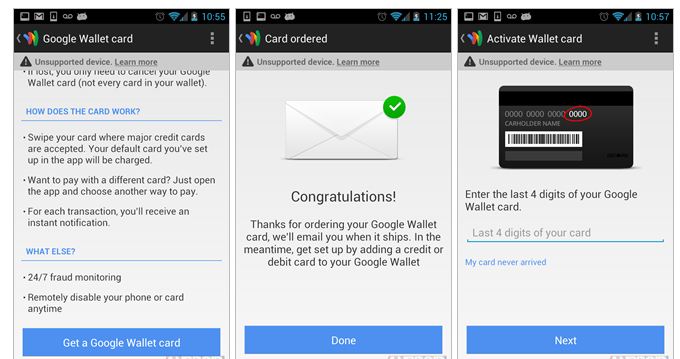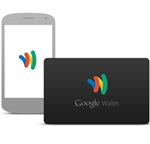2 Nov 2012
Android Police published a story on Google’s forthcoming plastic pilot yesterday.
What do we know? Very little beyond the photo above.. If the story does pan out, it could be a tremendous win for retailers, consumers and even banks. The only loosers? NFC and carrier led payment initiatives.
Solution overview:
- Everything that Wallet 2.0 does today on NFC, only now you can do it with a swipe of plastic
- In today’s NFC wallet, consumers scroll through their list of cards to choose the plastic they want. The picture from android police outlines how this will be the same for physical plastic “want to pay with a different card? Just open the app and choose another way to pay.. just as you can today only now there is no NFC dependency.
- New for consumers? well a cool looking black card.. all of your tickets, incentives, coupons in one place (in the cloud). Don’t worry about loosing your offer e-mails.. Google also has POS integration working at 10+ grocers so your coupons automatically come off on the paper reciept.. and in the cloud. No one else has payment and incentives put together like this.
- New for retailers? Integrated advertising.. look at performance of local search, adwords, offers, coupons across google properties.
Business Strategy Changes
- Expand beyond NFC phones to any Android handset (and IOS according to article)
- Allow offers to be redeemed on plastic
- Allow Google to compete for payments business with retailers and consortiums (ie MCX)
- One wallet for eCommerce, mCommerce, and a plastic card for POS. This is exactly what PayPal is doing with its own physical plastic, and American Express plans to do in SERVE 2.0.
- Expand Google wallet into IOS? That will certainly crimp Apple’s plans here. Google will establish itself as both a payment network AND and Ad network
- No more TSMs. Google will see the transaction data for every card used in the wallet. Just as Amazon, Apple, PayPal see every transaction for eCommerce.
My guess is that Google will proceed with a small scale pilot, just as it did with Wallet 1.0.
Why do retailers win? (see related blog)
Google will be in a position to drive the lowest cost payment (perhaps better than 0bps MDR) AND allow retailers to drive marketing to their consumers online and via mobile.
Why do consumers win?
With Google, use any card you want, use any phone you want … consumers get to CHOOSE. (In ISIS the only card you can load today is a Visa credit card)
Google sorry that some idiot spoiled your release plans.. but this is super stuff… I always wanted a black card.
My biggest questions?
- Will Google integrate a direct ACH connection.
- Who is the network?




Nice post.. Why do you say banks will benefit ? I would believe that being disintermediated would mean loss of key information and something banks will not be very happy about as in 1.x
Re: banks win. Well in the PayPal objective is to prioritize ACH.. In American Express’s model debit or ACH…. in Google’s model use any card you want. Bank loyalty programs stay intact. Traffic still stays with Visa and MA (perhaps even at card not present rates).
Rumor is it’s a Discover Network card, which is an interesting move given than the current hidden proxy card in the Google Wallet is a MasterCard BIN. We continue to see Discover Network more willing to innovate on these items, as many networks and banks are very concerned about Google Wallet (learned at the Google Wallet info session for banks at Money2020 last month)
Do you think that Google’s plastic card will actually be used to a greater extent than Paypal’s? What drives usage? Unless Google pays consumers to use it through some type of additional layer of loyalty. I’d use it if I could double up on loyalty rewards from both issuers.
Also – does this scheme impact the transaction data that banks get? How does this impact Cardlytics, Cardspring, Edo and other CLO platforms?
I think you will be able to do some doubling up…it all depends exactly how the CLOs process the merchant reward. If they are doing analysis of the posted txns then probably yes (unless they blacklist Google), but if they are working through the merchant acquiring networks then no. Google (like ISIS) seems to think that offers drive the adoption, something of which I am skeptical. I do think Google will get more usage than PayPal as the card swipe and direct wallet funding is more logical and clear in Google’s case than in PayPal’s, due to all of the ACH activity PayPal does.
We’re building Wallaby’s wallet services to focus on automated card choice that meets user preferences to enhance the wallet and make it truly more valuable. If we can help you pick the best card for each transaction (whether that be based on rewards, interest, payment due dates, balances, etc.) then you have a better reason to change your behavior.
I agree on doubling up… I don’t think merchants will like it at all. Believe it or not most CLOs operate on string matching of merchant name (not merchant ID) and Google is the merchant of record… but they have appended merchant name in most cases (at least in my NFC wallet). What merchants really want is line item offers… this is what Google is uniquely positioned to do and is already doing at a number of retailers.
Tom- Definitely believe how CLOs operate….we ran some of the first CLOs at Green Dot in 2006 and I recall writing the regular expressions to tease out the various ways a chain (e.g. CVS) might be written in merchant records. The end game is in SKU data to payments connection, but that will require merchant upgrade their POS to something much more capable and is where Square and other iPad POS companies are well-positioned.
The Google wallet team was stumped when this question (stacking up of CLO and Google-Merchant rewards) was asked during their Money2020 presentation to the FIs. It seemed like this use case wasn’t thought about yet or they didn’t want to let out their strategy.
Google may not be able to do what your (Wallaby) wallet may do because of their model. Looks like your wallet is purely consumer focused and hence you can pick the card best suited for the consumer. Google on the other hand is dealing with consumers, merchants and the Issuers. A good card /payment method for a consumer means either a merchant is paying higher card fee or the issuer with higher margin cards is getting affected.
Paypal, on the other hand, is totally consumer-unfriendly! It tries to make money with ACH option while maybe jeopardizing consumer’s Reg Z protection. (Imagine I wanted to use a credit card to pay for a dish washer at Home depot. If I use my PayPal card, I will end up paying through my bank account (ACH) and will not get the card protection!!) They are merchant-unfriendly too.. they charge the same rate (~150-200 bps) for the merchants irrespective of what payment method is used.. Finally, they are Issuer-unfriendly too..they route a possible credit card transaction into an ACH transaction and they hurt the issuers.
Sorry for the topic digression, but I wanted to point out that Google is in a much better position than PayPal at the retail POS. Am glad that Google didn’t just stick with the NFC option!
Excellent questions, I would like to know the answers too. Problem with PayPal is that I can’t select what underlying card I want the transaction to go on.. Yes data is impacted… I’m sure it is one of the discussion points with the networks and it drives Card Present/CNP rates .. and a number of other terms.
Tom, my perspectives on your questions:
1. Will Google directly integrate with ACH? I don’t think Google should invest its time and efforts in integrating with ACH. While it upsets the credit card issuers and networks, it doesn’t save much to Google. They can rather incentive the consumers to attach their debit card and route the transactions through that card to access the DDA and reduce their processing fee – thanks to Durbin. Interfacing with ACH would also mean having a bigger risk-mgmt team – the ACH savings compared to debit card rates would then diminish. (I think PayPal or Amazon also would not have chosen ACH integration if Durbin rules were in force at that time!)
2. Who is the network? It is a great question and I have also been thinking about it for sometime now as I hear about wallets, rails and their combinations. However, if you dive deeper, I think it is still premature for anybody else to become a network or even closer to a network.. I have put my thoughts in my post at http://www.niksepa.com/?p=494 . Google brings a new functional element to the network, but is far from being one… What do you think?
re #2. My hypothesis is a “commerce orchestration network”… virtual and phyiscal, focused on advertising and customer acquisition. Payment networks are attempting to add advertising (CLOs) and ad networks are attempting to add payment. The problem to be solved is largely advertising, which requires consumer contact, consumer data, and campaign management. I certainly have views on who is more effective solving this problem. There is a higher probability for ad networks to conquer this space by adding payment “dumb pipes” than for payment providers to gain intelligence (sorry for the pun).
Pingback: Future or Retail Banking: Prepaid? « FinVentures
Agree with you on the commerce orchestration network.. I call it the Commerce uber-network… Not many companies can become this uber-network. I have expanded my thoughts here: http://www.niksepa.com/?p=504
Pingback: Payment News for May.. What a Month! | FinVentures
Pingback: Google in Payments: Why Yesterday was BIG News | FinVentures
Pingback: Payments – Wrapping, Rules, Acquiring and Tokens | FinVentures
Pingback: Wells gets and A+: New Amex Partnership | FinVentures
Pingback: Not on my Rails | FinVentures
Pingback: Money 2020: Tokens and Networks | FinVentures
Pingback: Divide and Conquer: Commerce Battlefield | FinVentures
Pingback: Google+Softcard Levels Field Against Apple - Starpoint Blog - Finventures
Pingback: Apple Card – Noyes Payments Blog